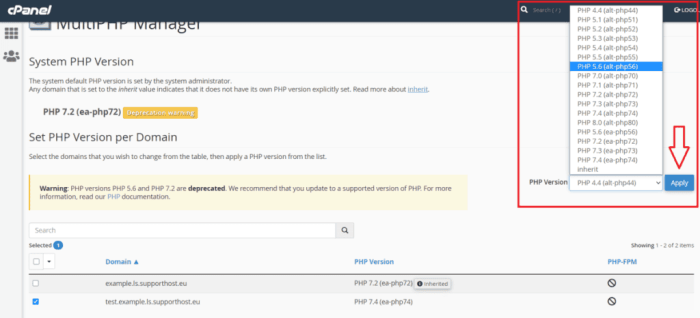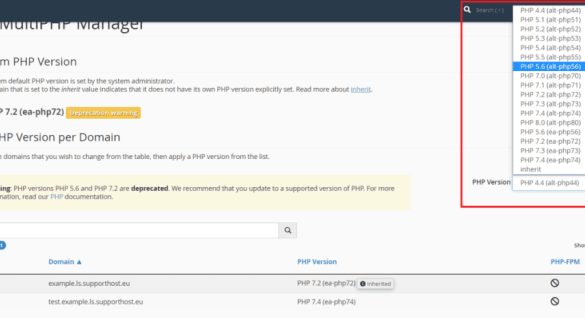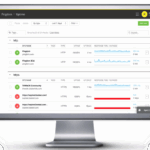Updating the PHP version is a crucial step for any WordPress site owner. It’s not just about keeping things up-to-date; it’s about securing your site, improving performance, and ensuring your applications remain compatible with the latest technologies.
This guide will walk you through the entire process, from assessing your current environment to handling potential issues and ensuring post-upgrade maintenance. We’ll explore why updates are essential, the benefits of upgrading to newer PHP versions, and common reasons developers might delay the process. A deep dive into the practical steps will be presented, including how to back up data, check for compatibility, and troubleshoot potential problems.
We’ll cover various methods for updating PHP, from manual procedures to using package managers. The guide will also delve into the security considerations involved and the importance of thorough testing. Finally, we’ll discuss post-upgrade maintenance to keep your site running smoothly and securely.
Introduction to PHP Version Updates
Keeping your PHP installation up-to-date is crucial for maintaining a secure and performant website. Outdated versions often lack critical security patches, leaving your application vulnerable to exploitation. This article explores the importance of PHP version updates, highlighting the benefits and addressing common hesitations.PHP, a widely used server-side scripting language, undergoes continuous development. Each new release brings significant improvements in security, performance, and features.
Regular updates are not just recommended, but essential for ensuring the continued reliability and safety of your web applications.
Importance of PHP Version Updates
Outdated PHP versions are a significant security risk. They expose your website to known vulnerabilities that malicious actors can exploit. Staying current with security patches is paramount to protecting your data and user information. Failure to update can lead to compromised accounts, data breaches, and reputational damage.
Benefits of Upgrading to Newer PHP Versions
Modern PHP versions offer substantial improvements over older ones. These improvements translate to enhanced performance, better security, and support for cutting-edge technologies. Upgrading can result in faster page load times, reduced server strain, and improved overall user experience. Furthermore, newer versions often include new features and functionalities that can streamline your development process.
Keeping your PHP version up-to-date is crucial for website security. While upgrading PHP can sometimes be a bit tricky, it’s a necessary step to maintain a robust online presence. This often involves careful consideration, but it’s worth it! For example, if you’re looking to add a PDF viewer to your WordPress site, ensuring the right PHP version is essential for compatibility.
Fortunately, there are clear tutorials available, like how to add a pdf viewer in wordpress , which will help you navigate the process. In the end, staying on top of your PHP version is vital for a secure and functional website.
Common Reasons for Delaying PHP Updates
Several factors might contribute to developers’ reluctance to update PHP versions. Concerns about compatibility issues with existing codebases are frequently cited. The fear of breaking functionality, requiring extensive code refactoring, and the perceived time investment involved often deter developers. Furthermore, a lack of clear understanding of the upgrade process can contribute to the delay.
Key Differences Between PHP Versions
| PHP Version | Security Enhancements | Performance Improvements | Notable Features |
|---|---|---|---|
| PHP 5.6 | Improved protection against common exploits. Basic security patches and bug fixes. | Moderate performance gains compared to earlier versions. | Support for MySQLi, PDO, and other database drivers. |
| PHP 7.0 | Significant improvements in security, addressing critical vulnerabilities. Enhanced protection against SQL injection and cross-site scripting (XSS) attacks. | Substantial performance boost, often doubling or tripling the speed of applications compared to PHP 5.6. | Support for features like anonymous functions, generator functions, and return type declarations. |
| PHP 8.0 | Improved security features, including enhanced protection against exploits targeting object serialization and deserialization. | Further performance optimizations, including improvements in opcode caching and JIT compilation. | Introduction of new features such as match expressions, attributes, and named arguments. |
This table highlights some of the key differences across various PHP versions. Each newer version builds upon the strengths of its predecessors, addressing existing weaknesses and adding valuable new functionalities.
Assessing Your Current Environment: Updating The Php Version
Before embarking on a PHP version upgrade, a thorough assessment of your current environment is crucial. Understanding your existing PHP installation, application compatibility, and dependencies is paramount to a smooth and successful upgrade. This proactive step helps mitigate potential issues and ensures a stable transition.A critical first step involves determining the precise PHP version currently running on your server.
This information is essential for understanding compatibility with the new version and planning accordingly. Accurate identification of installed PHP extensions and modules is also vital. These components are integral parts of your application’s functionality and require careful consideration during the upgrade process. Database compatibility is another critical area. A mismatch between your database system and the new PHP version can lead to data corruption or application malfunctions.
Determining the PHP Version
Knowing the current PHP version is fundamental for planning the upgrade. Several methods exist to identify the installed PHP version.
- Using the command line: Executing the `php -v` command in your server’s terminal provides a straightforward way to display the current PHP version. This command is a common and reliable method for retrieving the PHP version.
- Utilizing the `phpinfo()` function: The `phpinfo()` function, accessible within a PHP script, displays detailed information about the PHP configuration, including the version. This allows for a more comprehensive view of the installed PHP version, along with other configuration details, including extensions and modules.
Verifying Application Compatibility
Thorough testing is necessary to ensure your applications are compatible with the new PHP version. A critical aspect of this verification is identifying potential conflicts with PHP extensions or modules.
- Reviewing application code: Examine your applications’ code for any direct dependencies on specific PHP functions, extensions, or versions. Look for potential conflicts that might arise when upgrading.
- Running compatibility tests: Conduct thorough testing of your applications on a staging environment or a test server using the new PHP version. This proactive measure helps identify any compatibility issues before deploying the upgrade to your production environment. This approach is critical to prevent unexpected issues post-upgrade.
Checking PHP Extensions and Modules
Identifying installed PHP extensions and modules is essential to understand the dependencies of your applications.
- Using `phpinfo()`: The `phpinfo()` function provides a comprehensive list of installed extensions and modules, allowing for an assessment of the components used by your applications.
- Manual inspection: Consult your application’s documentation and codebase to identify the required extensions. Verify that these are present in your current PHP installation.
Database Compatibility Checks
Ensuring database compatibility during an upgrade is crucial to prevent data loss or application malfunctions.
- Testing database queries: Test the compatibility of your database queries with the new PHP version. Use a test database to run queries to ensure the new version doesn’t introduce conflicts.
- Upgrading database drivers: If necessary, update the database drivers to ensure compatibility with the new PHP version. This step is vital to avoid any issues arising from driver incompatibility.
Comparison of Methods for Checking PHP Version
| Method | Description | Example |
|---|---|---|
| `php -v` | Command-line tool to display PHP version. | `php -v` |
| `phpinfo()` | PHP function to display PHP configuration details. | |
Planning the Upgrade Process
Successfully updating your PHP version requires a well-defined plan. This phase focuses on creating a step-by-step procedure, ensuring data backups, and anticipating potential problems. Careful planning minimizes risks and ensures a smooth transition.A methodical approach to upgrading PHP is crucial. This involves not only understanding the steps involved but also anticipating potential pitfalls and having strategies to address them.
Proper preparation, including thorough backups and testing, is essential to prevent downtime and data loss.
Creating a Step-by-Step Procedure
A detailed step-by-step procedure for upgrading PHP minimizes errors and maximizes efficiency. This approach includes preparatory actions, the actual upgrade, and post-upgrade checks.
- Assessment and Preparation: Identify the PHP version to upgrade to, and ensure all necessary dependencies are compatible with the new version. Verify sufficient server resources are available to handle the upgrade.
- Backup Crucial Data and Configurations: This step is paramount. Back up your database, website files, and configuration files (e.g., .htaccess, php.ini). Utilize a reliable backup method, such as rsync or a dedicated backup solution. Verify the integrity of the backup before proceeding.
- Testing in a Staging Environment (Recommended): Before upgrading your live site, perform the upgrade in a staging environment. This allows you to identify and fix any issues before affecting live traffic. This step minimizes the risk of significant problems on your live server.
- Upgrade PHP: Follow the specific instructions for your operating system and package manager (apt, yum, etc.). Ensure the upgrade process is executed correctly. Verify that the upgrade completed successfully.
- Verify Website Functionality: After the upgrade, thoroughly test all aspects of your website to ensure everything functions correctly. Check for errors, broken links, and unexpected behavior.
- Update Configuration Files: Adjust your php.ini file, if needed, to accommodate any changes in the new PHP version. Check for any specific instructions from the PHP documentation.
- Monitor Server Performance: Post-upgrade, closely monitor server resources, such as CPU usage, memory, and disk I/O. This ensures the server is performing optimally with the new PHP version.
Backing Up Crucial Data and Configurations
Regular backups are essential for disaster recovery and are particularly crucial during a PHP version update. This process safeguards against data loss and ensures a smooth upgrade process.
Data backups are vital to prevent data loss during PHP version upgrades. Implement a robust backup strategy that includes both website files and database content.
Regularly backing up your data and configurations protects against unforeseen circumstances and ensures data recovery if anything goes wrong during the upgrade. Choose a backup method that fits your needs and resources.
Strategies for Handling Potential Issues
Anticipating potential issues during the upgrade process is crucial. Having strategies to address these issues can prevent downtime and data loss.
- Error Logging: Configure your server to log errors during the upgrade process. This enables you to identify and diagnose any problems quickly. Thorough error logs aid in troubleshooting.
- Rollback Plan: Develop a rollback plan. This should involve reverting to the previous PHP version if necessary. Ensure you have a copy of the previous configuration files and database backups to revert to.
- Communication and Monitoring: Communicate the upgrade process to relevant stakeholders and monitor the server’s performance closely throughout the process. This allows you to promptly address any issues that arise.
Updating PHP Using Package Managers
Package managers (apt, yum, etc.) streamline the PHP update process. Using package managers can simplify the upgrade process and minimize manual intervention.
- Using apt (Debian/Ubuntu): Use the `apt` command to update PHP. Specific commands vary depending on the PHP package. For example: `sudo apt update` followed by `sudo apt upgrade php`.
- Using yum (CentOS/RHEL): Utilize the `yum` command for updates. The exact command structure may vary, but the general approach involves updating the package list and then upgrading PHP using `yum update php`.
Comparing Upgrade Methods
The table below compares manual and package manager methods for PHP version upgrades.
| Feature | Manual Upgrade | Package Manager Upgrade |
|---|---|---|
| Complexity | Higher | Lower |
| Risk | Higher | Lower |
| Speed | Variable | Generally Faster |
| Error Handling | Requires manual error checks | Automated error handling |
Handling Potential Issues
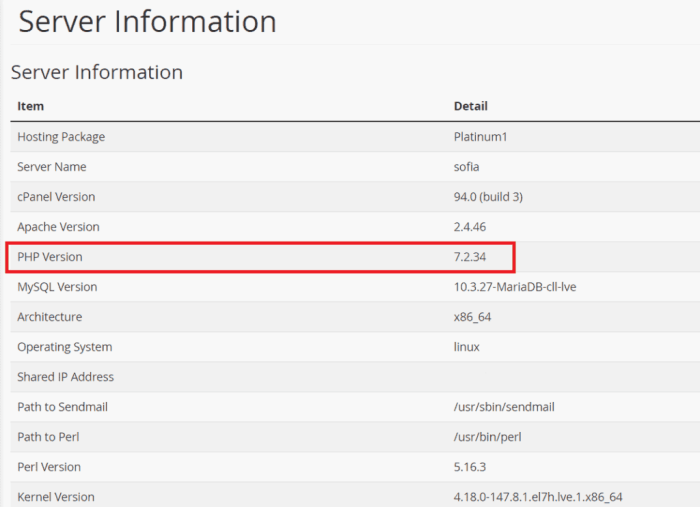
Updating PHP versions, while often necessary for security and performance improvements, can introduce unexpected complications. This section delves into common pitfalls encountered during upgrades and provides practical strategies for navigating them successfully. Understanding potential issues allows for proactive problem-solving, minimizing downtime and ensuring a smooth transition.PHP upgrades often involve intricate dependencies. Mismatched versions between PHP and its extensions can lead to critical errors.
Compatibility problems with existing web applications are also a significant concern. Proper planning and meticulous troubleshooting are crucial to mitigating these issues.
Common PHP Upgrade Errors
A thorough understanding of potential errors is vital for a successful PHP upgrade. Different errors arise from various causes, ranging from misconfigured extensions to incompatibility issues with applications. Identifying the source of the problem is paramount to a swift resolution.
Conflicts with Extensions
Extensions are crucial components of PHP, providing specific functionalities. Conflicts arise when the PHP version is incompatible with existing extensions. Carefully reviewing the extension’s compatibility matrix is crucial before proceeding with the upgrade.
- Verify extension compatibility with the new PHP version. Consult the extension’s documentation or the PHP extension repository for compatibility information.
- Reinstall or update extensions to ensure they align with the new PHP version. This often requires specific installation procedures detailed in the extension’s documentation.
- Examine the extension’s configuration files to check for potential mismatches or outdated settings. Ensure configuration options are compatible with the new PHP version.
Troubleshooting Compatibility Issues with Web Applications
Compatibility issues with web applications are common after a PHP upgrade. Thorough testing is essential to identify and resolve these issues.
- Run comprehensive tests on the application. Use a staging environment to test the application with the new PHP version before deploying it to the production server.
- Examine error logs. Analyze logs to identify specific errors or warnings associated with application functionality after the upgrade. Focus on errors related to PHP functions or libraries.
- Consult the application’s documentation. Refer to the documentation for specific instructions on upgrading the application or for troubleshooting compatibility issues.
Diagnosing Errors and Identifying Root Causes
Effective troubleshooting requires a systematic approach to diagnosing and resolving issues.
Figuring out how to update your PHP version can be tricky, especially when you’re juggling other crucial tasks like target market research for the professional services. Understanding your client base and their needs through research, like that outlined in this guide target market research for the professional services , is vital, but ensuring your platform is up-to-date with the latest PHP version is equally important for a smooth operation.
Staying ahead of the curve in terms of PHP versions is essential for security and performance.
- Utilize debugging tools. Leverage PHP’s built-in debugging tools to pinpoint the source of errors and examine variable values during runtime.
- Employ a methodical approach. Break down the problem into smaller, manageable components to isolate the specific cause of the error.
- Consult online resources. Utilize online forums, communities, and documentation to search for solutions to specific errors or issues encountered.
Table of Common PHP Upgrade Errors and Solutions
This table provides a concise overview of common errors and their corresponding solutions.
| Error | Solution |
|---|---|
| “Fatal error: Class ‘PDO’ not found” | Verify that the PDO extension is enabled and installed correctly. Check php.ini for PDO extension configuration. |
| “Warning: Unknown: … in … on line …” | Ensure the PHP code is compatible with the new version. Review the updated documentation for changes in function syntax or deprecated features. |
| “Error: Call to undefined function …” | Verify that the necessary function is available in the new PHP version. Review the PHP documentation for the function’s compatibility. |
Testing and Verification
After successfully upgrading your PHP version, rigorous testing is crucial to ensure everything operates as expected. This phase verifies the new version’s compatibility with your existing applications and databases, preventing unexpected issues post-upgrade. Thorough testing minimizes downtime and ensures a smooth transition to the new PHP environment.
Thorough Testing Procedures
Comprehensive testing after a PHP version update is essential. It goes beyond just checking if the update installed correctly. You need to validate the application’s functionality, database interactions, and overall system performance with the new PHP environment. This proactive approach mitigates potential problems that might arise from incompatibility or unexpected behavior.
Methods for Verifying Successful Installation
Several methods exist for verifying the successful installation of the new PHP version. These methods range from simple command-line checks to more complex automated tests. The most effective approach depends on the scale and complexity of your application. Checking PHP’s version through command-line commands is a straightforward initial verification step.
Testing Application Functionality
Testing application functionality involves verifying that all core features operate as expected under the new PHP version. This includes interactions with user interfaces, form submissions, and other crucial aspects of the application. Functional testing should encompass various scenarios, including positive cases (expected behavior) and negative cases (edge cases or error conditions). For example, if a form has validation rules, ensure they still function correctly with the new PHP version.
This ensures smooth user experience.
Testing Database Interactions
Database interactions must also be rigorously tested. Verify that queries run successfully and return accurate results. Test different data types, complex queries, and potentially problematic data inputs to identify any issues related to database interactions. This step ensures data integrity and prevents potential data corruption. For instance, run queries that extract, update, or delete data to validate data retrieval and modification functions.
Automated Testing Procedures for Web Applications
Automated testing significantly streamlines the process of verifying application functionality. Tools like Selenium and PHPUnit can automate various tests, ensuring consistent and comprehensive coverage. These tools can automate regression testing, ensuring that new features or changes don’t introduce regressions to previously working code. Example: PHPUnit tests can verify that a user login form validates input correctly and logs the user in properly.
These tests should be integrated into the development workflow to ensure continuous testing.
Comparison of Testing Methodologies
| Testing Methodology | Description | Advantages | Disadvantages |
|---|---|---|---|
| Unit Testing | Testing individual components in isolation. | Early defect detection, increased code maintainability. | Can miss integration issues, less comprehensive than other methods. |
| Integration Testing | Testing interactions between different components. | Identifies issues arising from component interactions, broader test coverage. | More complex to set up, can be time-consuming. |
| System Testing | Testing the entire system as a whole. | Ensures the system meets requirements, identifies end-to-end issues. | Very time-consuming, can be expensive. |
| User Acceptance Testing (UAT) | Testing by end-users to validate the system’s usability. | Identifies usability issues, ensures system meets user expectations. | Requires user involvement, can be subjective. |
Post-Upgrade Maintenance
Successfully upgrading your PHP version is just the first step. Post-upgrade maintenance is crucial for ensuring your applications continue to function seamlessly and remain secure. This phase involves meticulous monitoring, proactive security measures, and a systematic approach to resolving any lingering issues. Careful planning and execution in this phase minimize downtime and maximize the benefits of your upgrade.
Ensuring Application Functionality
Thorough testing before the upgrade is essential, but verifying all applications still function correctly after the update is equally vital. A comprehensive checklist of all applications is recommended. This should include not only web applications but also command-line tools or scripts that rely on PHP. Manual testing is critical. Manually interacting with each application to verify functionality and data integrity is a necessary step.
Automated tests, if available, should be integrated into the post-upgrade validation process.
Updating PHP can be a bit of a headache, especially if you’re not careful. One thing to consider is how it might affect your existing redirects. For instance, if you’re upgrading your website’s infrastructure, you might need to understand 301 redirect chains intro to avoid breaking important links. So, while updating PHP, double-check your redirect setup to ensure a smooth transition.
It’s a crucial step in the process, ultimately ensuring a seamless experience for your site visitors.
Monitoring Server Performance
Monitoring server performance after the upgrade is paramount. Key performance indicators (KPIs) should be tracked. These include CPU usage, memory consumption, and response times. Regular monitoring allows you to identify potential bottlenecks or performance regressions. Real-time monitoring tools can provide valuable insights into server resource utilization.
Automated alerts should be configured for significant deviations from baseline performance. This proactive approach helps you identify and address performance issues promptly.
Maintaining PHP Security
Securing the updated PHP version is crucial. Keeping the PHP version up-to-date with the latest security patches is vital. The most recent version will have the most significant security fixes and should be prioritized. Regular security audits should be conducted to identify potential vulnerabilities. A penetration test can simulate real-world attacks to discover vulnerabilities.
The PHP security extensions and modules should be reviewed. Updating these components can provide critical security enhancements.
Addressing Remaining Issues
A post-upgrade checklist for troubleshooting any remaining issues is critical. Thorough logging should be enabled to provide detailed information about errors or exceptions. This detailed information helps in isolating the problem and finding a solution. Regularly review the logs to identify patterns. If a specific error persists, consult the PHP documentation, online forums, or community support channels for assistance.
Thorough debugging skills and a structured approach to problem-solving will assist in quickly finding and fixing errors. Testing thoroughly will reduce the likelihood of errors occurring post-upgrade.
Post-Upgrade Maintenance Tasks, Updating the php version
| Task | Description | Frequency |
|---|---|---|
| Application Functionality Check | Verify all applications function correctly after the upgrade. | Immediately after upgrade, then periodically |
| Server Performance Monitoring | Track CPU usage, memory, and response times. | Daily |
| PHP Security Updates | Apply security patches promptly. | Weekly/Monthly depending on release cadence |
| Security Audits | Identify and remediate potential vulnerabilities. | Quarterly |
| Issue Resolution | Address any remaining issues or bugs. | As needed |
Security Considerations
Updating your PHP version is crucial not just for performance and compatibility, but also for bolstering your application’s security posture. Older versions of PHP often harbor known vulnerabilities that malicious actors can exploit. Addressing these vulnerabilities proactively through an upgrade significantly reduces the risk of breaches and data compromises.PHP’s evolution incorporates robust security enhancements, which are vital in mitigating threats.
These improvements, coupled with a proactive patching strategy, fortify your application against emerging and known threats.
Vulnerabilities in Older PHP Versions
Older PHP versions frequently expose applications to a range of security risks. These vulnerabilities can stem from flaws in core components or inadequate handling of user input. Unpatched vulnerabilities allow attackers to gain unauthorized access, execute malicious code, or steal sensitive data. Examples include remote code execution vulnerabilities, cross-site scripting (XSS) flaws, and SQL injection vulnerabilities. These are all significantly reduced by migrating to more recent versions.
Leveraging Security Features in Newer PHP Versions
Newer PHP versions introduce several security enhancements designed to mitigate the vulnerabilities of older versions. These features often include improved input validation, enhanced error handling, and stricter security protocols. For instance, newer versions often employ more robust mechanisms for preventing cross-site scripting (XSS) attacks. These advancements can dramatically reduce your application’s attack surface.
Importance of Patching Vulnerabilities
Patches are essential to address security vulnerabilities discovered after a PHP version update. Delaying patching exposes your application to potential exploits. Regularly applying security patches is a critical component of maintaining a secure system. Failure to do so can result in serious security breaches. A successful attack can have significant financial and reputational repercussions for a company.
Best Practices for Securing the PHP Installation
Proper configuration is key to a secure PHP installation. Implementing strong password policies for administrative accounts and restricting access to sensitive data is essential. Employing secure coding practices in your application code is equally important. Using prepared statements for database interactions, for example, helps mitigate SQL injection vulnerabilities.
Security Improvements Across PHP Versions
| PHP Version | Key Security Improvements |
|---|---|
| PHP 5.6 | Improved handling of user input, addressing certain vulnerabilities present in earlier versions. |
| PHP 7.0 | Introduced stricter type hinting, improved error handling, and enhanced security measures in several areas, leading to fewer exploitable weaknesses. |
| PHP 7.4 | Further refined security practices, including improvements in handling potential exploits and introducing more robust validation mechanisms. |
| PHP 8.0 | Introduced significant enhancements in security by addressing several previously identified vulnerabilities, improving code analysis, and refining handling of dangerous functions. |
End of Discussion
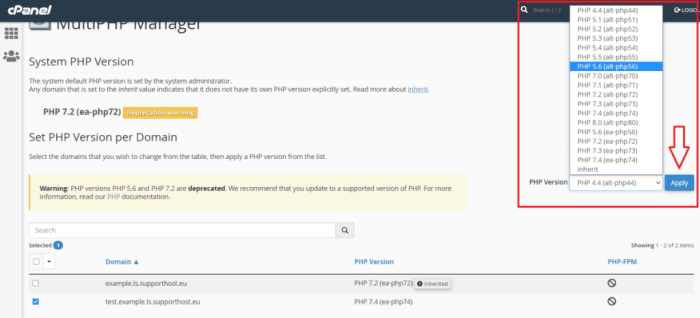
In conclusion, updating your PHP version is a significant undertaking, but with careful planning, thorough testing, and a proactive approach to potential issues, it can lead to a more secure, efficient, and modern website. This guide provides a comprehensive roadmap, empowering you to navigate the process confidently. Remember to always prioritize security and thoroughly test your application after any upgrade.
By following the steps Artikeld, you can ensure a seamless and successful PHP version update.

